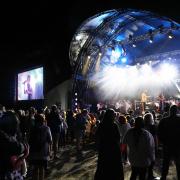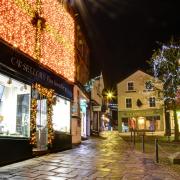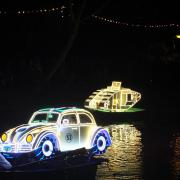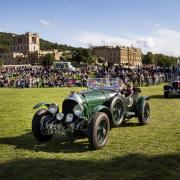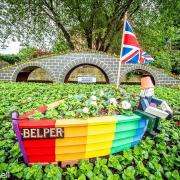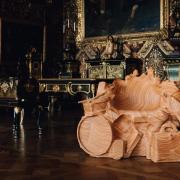Peter Seddon resurrects the once-famous railway team whose fleeting existence from 1881 to 1891 is crucially intertwined with the long life of Derby County

Manchester City and Manchester United, Liverpool and Everton, Nottingham Forest and Notts County – cities possessing two or more professional football clubs are not uncommon. With that comes the partisanship – often friendly but not always – which divides communities and even families.
Such splits give Derby County an extra dimension – even a superior edge – for the club is sole representative of its city, and with Chesterfield one of only two Football League clubs in Derbyshire. Over their long years of existence this has helped make ‘The Rams’ a true community club with a loyal following sharing a single bond.
Yet it might have been different, for when Derby County formed in 1884 the town already had a club of considerable repute – the railway side Derby Midland – which immediately rivalled Derby County in the quest for supremacy. Had both survived, the city might now be split between ‘The Rams’ and ‘The Mids’ – or perish the thought, had the older railway club prevailed absolutely, then the young upstart Derby County might never have survived beyond infancy.
But in fact Derby Midland foundered while Derby County flourished – with such permanency that ‘The Rams’ are currently enjoying their 130th anniversary. In contrast Midland perished in 1891 after only a decade – as such it would be easy to dismiss ‘The Mids’ as mere ‘shadows of the past’. But that would be a disservice to a club which was once a leading light in Derbyshire sport. Indeed both directly and indirectly the ‘ghosts in black and white stripes’ helped Derby County become what they are. Their story deserves telling...

The railway club’s prehistory began with the creation of the Midland Railway Company in 1844. Derby became its headquarters and soon the burgeoning ‘railway town’ was home to countless Midland employees. In 1851 – the concept of ‘leisure-time’ then gaining currency – a group of Midland Railway accounts clerks formed the Midland Railway Cricket and Quoits Club.
Quoits faded but cricket flourished. Osmaston Park provided an initial base, but in 1852 the Midland Railway made land available to rent north of the station – just across the Derwent accessed by Siddals Bridge. This ‘Midland Ground’ survived as a sports club to within living memory of older Derby residents, and although now overgrown the turf which once staged stirring cricket and football contests in Queen Victoria’s reign is still there. Eerily evocative of a lost age, one might almost hear the faintest of cheers.
An athletics section was soon added, then bowls, and in the 1870s the ‘new sport’ Lawn Tennis. Football came later – but as the game rapidly developed in the 1870s its adoption by the Midland Railway was irresistible. On Monday 20th June 1881 in the pavilion of the Midland Cricket Club it was unanimously decided to form the Midland Railway Football Club, soon tagged Derby Midland.
Nominal founder and first captain was 23-year-old clerk Henry Evans. Already a mainstay of the pioneering Derby Town FC (established 1869) he instantly defected to Midland along with several other ‘Townites’. Within a year ‘dear old Town’ had folded – it was said that ‘no tears were shed by the Midland’, but a judgement of sorts lay ahead, for when Derby County formed in 1884 the Midland ranks would be raided by them with equal disregard for sentiment.

In the interim the ‘Mids’ progressed apace, centre-forward Evans proving a formidable leader. Also a Derbyshire cricketer, he was born at Codnor Park Farm, Stoneyford, Derbyshire – making great strides in his profession, he was appointed in 1905 Chief Goods Manager of the Midland Railway. The ‘Founding Father of Midland Railway F.C.’ died in 1920 aged 64 at his home ‘The Beeches’, Spondon, and rests eternal in Spondon churchyard.
Football had travelled far by then, but Evans surely recalled the pivotal happenings of 1884. In May that year Derbyshire County Cricket Club decided to follow the Midland model – Derby County Football Club was born. Three-year-old Derby Midland was then the town’s foremost club – but Derby County launched a shameless recruitment drive.
The fledgling club’s first two ‘signings’ Haydn Morley and George Bakewell both defected from Midland – and more followed suit. Even Henry Evans wore Derby’s then ‘chocolate, amber and blue’ once, before work took him to Glasgow, where he assisted the famous amateur side Queen’s Park.
Considering its own dismemberment of Derby Town, the Midland committee might have stoically accepted ‘that’s football’. But instead full hostilities were declared. What further nettled the Midland hierarchy was that the Derby County founder and chairman William Morley – father of first captain Haydn - was a senior clerk at the Midland Railway. That sir is treachery!

A Midland spokesman told the press: ‘There is no wonder that many who have worked hard for many years in the interests of local football should feel sore that a new club, claiming to represent the county, has stepped in and tried to reap all the advantages of players ready-trained for them at the expense of other clubs.’ With that somewhat disingenuous bleat the ‘gloves were off’ – the Derby County camp stiffened its resolve and frequent vitriol ensued. For three whole seasons Derby County and Derby Midland refused to play each other.
When the clubs eventually met in 1887-88 Midland gleefully won the inaugural encounter, but later that season County prevailed in two further showdowns. By then the younger ‘upstart’ was already rising ominously – and significantly football had changed markedly in just a few years. Crucially ‘professionalism’ – the paying of players – had been legalized in 1885. This sharpened competition between rival clubs for the best talent and biggest gates – the press now mused that a town of Derby’s size could not support ‘two sides with big pretensions’.
It seemed inevitable that either Midland or County must retreat to the shadows – if not fold completely. The hammer blow to Midland’s ambition fell in 1888 when the Football League was formed – the ‘Mids’ seniority was overlooked, while the thrusting ‘junior partner’ Derby County calmly accepted an invitation as founder members. With cruel irony a League spokesman stated that a key factor in Derby County’s election was ‘the convenience afforded for visitors by the excellent transport network provided by the Midland Railway.’ The ‘Mids’ had been usurped with a vengeance – renewed bitterness reigned.
In response to the new Football League a group of unelected clubs formed the Midland League for 1889-90, something akin to a Third Division – Derby Midland finished as first runners-up, but there was then no automatic promotion to a higher level. The ambitious but thwarted club acquired the dubious sobriquet the ‘Poor old Mids’. They gamely battled on and took valued scalps – including victories over League status Derby County in Cup and ‘friendly’ contests – but time was running out.
For 1890-91 Midland leased the Baseball Ground as their new home in an effort to boost support. This was the final chance to turn the corner – they might have taken up permanent residence in that populous area, but Derby County kept a step ahead. Supporters preferred top League football, and it would be the Rams who in 1895 made that atmospheric enclosure its own.
Meanwhile for Midland the whole football business was proving cripplingly expensive – and Midland Railway senior management became increasingly uncomfortable paying professional players under its company umbrella. When the 1890-91 campaign closed, serious talks were held, and in June 1891 some unexpected news was announced – ‘Derby County and Derby Midland have agreed an amalgamation.’
The wording was diplomatic. In truth Derby County completely absorbed its rival, covering the Midland’s £100 debt and taking all its players. Among the array of talent was an upcoming youngster named Steve Bloomer – no wonder one newspaper later described the takeover as the ‘football bargain of the century’. Derby Midland Football Club was dead after just ten years – slain by an imitator three years its junior. Derby County’s most crucial triumph...
Thereafter both County and Midland men formed distinct factions on the Rams’ committee, but slowly old wounds healed. In time as a nod to ‘common blood’ Derby County adopted Midland’s black and white stripes as their changed colours, and sportingly named their reserves Derby Town in honour of that earlier close relative. So sentiment finally emerged – although as long as Midland men lived there were those proud to declare their old allegiance.
A number of Midland players lived beyond the Second World War – Haydn Morley until 1953, probably the last survivor – but with their demise memories of the club faded. That is a shame, for their ‘Who’s Who’ contains some remarkable characters, among them Derbyshire cricketer L.G. Wright, and celebrated brothers William and Harry Storer – both played cricket for Derbyshire, and William for England, while Harry also kept goal for Arsenal and Liverpool.
Tellingly around 50 players wore the colours of both Derby Midland and Derby County – so the clubs were siblings of sorts, and brothers will fight. Assuredly Derby County owe far more than mere enmity to Derby Midland – so when that tribal cry ‘Come On You Rams’ fills the iPro Stadium... spare a thought for the ‘Poor Old Mids’.






